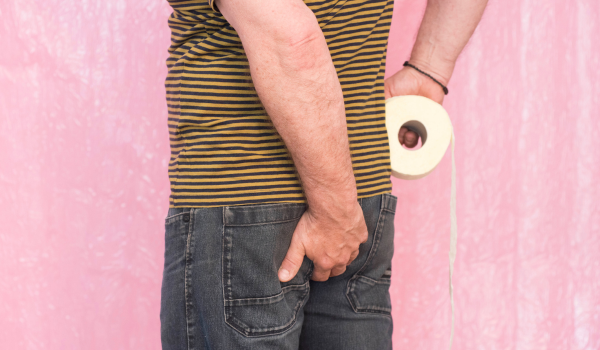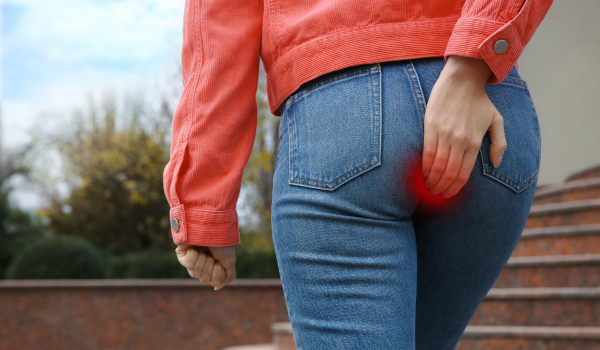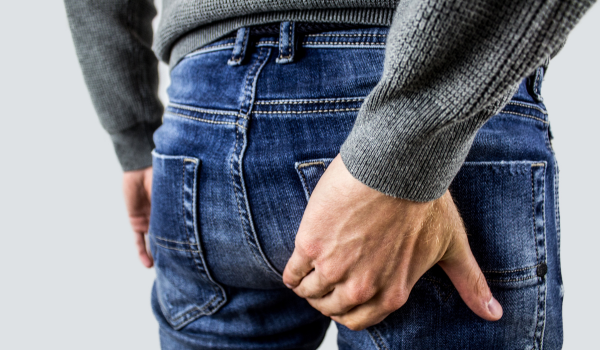Hemorrhoids, also known as piles, are swollen blood vessels in or around the anus. They can be either external (just outside the anus) or internal (inside the anus in the lower rectum). Prolapsed hemorrhoids are a type of internal hemorrhoid in which swollen veins bulge out from inside the rectum.
Anyone can develop hemorrhoids, but symptoms of a prolapsed hemorrhoid are most common between the ages of 45 and 65.
Common symptoms include bleeding, itching, and pain in the anal area. Home remedies and non-surgical procedures often relieve symptoms, while more severe cases may require surgery.
Symptoms
Internal hemorrhoids are usually not visible from the outside and often do not cause noticeable symptoms. The most common sign is bleeding from the rectum, which may appear as bright red blood in stools, in the toilet, or on toilet paper. Noticing blood when you use the bathroom should prompt a visit to your healthcare provider for evaluation.
When an internal hemorrhoid becomes so swollen that it prolapses, or protrudes from the anus, it can cause discomfort or rectal pain. The pain may be severe, especially if the hemorrhoid is completely prolapsed. Some prolapse only during bowel movements.
Other symptoms of prolapsed hemorrhoids include:
-
Itching or irritation around the anus
-
Mucus discharge from the anus
-
Fecal incontinence (leakage)
-
A wet sensation around the anus
-
A feeling of fullness in the anus
What Causes a Prolapsed Hemorrhoid?
Internal hemorrhoids result from increased pressure on the veins inside the rectum. This pressure can weaken the veins, causing them to bulge. When swelling becomes significant and surrounding tissues weaken, a prolapse can occur.
Risk Factors
Factors that increase rectal vein pressure:
-
Straining during bowel movements
-
Long-term diarrhea
-
Low fiber intake
-
Frequent laxative use
-
Regular heavy lifting
Other factors that weaken supporting tissues:
-
Aging
-
Pregnancy
-
Genetics
Diagnosis
If you have risk factors or symptoms, it’s important to see your primary care provider. They may refer you to a gastroenterologist or colorectal surgeon for further evaluation.
The diagnostic process may include:
-
Asking about your symptoms, diet, bowel habits, and medical history
-
Visual inspection of the anus for prolapse and signs like leakage or fissures
-
Asking you to strain during examination to check for prolapse
Tests to confirm diagnosis and rule out other conditions:
-
digital exam: A gloved finger is inserted into the rectum to check muscle tone, bleeding, or lumps
-
anoscopy: A hollow tube with a light is inserted to examine rectal lining
-
rigid proctosigmoidoscopy: A short metal tube is used to view the rectum and lower colon
-
colonoscopy: Recommended if there is bleeding, to rule out serious conditions such as cancer
Stages of Prolapsed Hemorrhoids
-
Grade 1: No prolapse
-
Grade 2: Prolapse occurs but retracts on its own
-
Grade 3: Prolapse occurs but can be pushed back manually
-
Grade 4: Constant prolapse that cannot be pushed back
How to Treat Prolapsed Hemorrhoids
Treatment depends on the cause and severity of symptoms. If there are no symptoms, medical treatment may not be necessary. For symptomatic prolapse, options range from home remedies to surgery.
At-home treatments
-
Increase fiber intake through foods or supplements
-
Drink more water and hydrating fluids
-
Use over-the-counter stool softeners if constipated
-
Avoid sitting too long or straining on the toilet
-
Take warm sitz baths a few times daily
-
Use OTC pain relievers to ease discomfort
In-office procedures
-
rubber band ligation: A rubber band cuts off blood supply to the hemorrhoid, causing it to shrink and fall off
-
sclerotherapy: A chemical is injected to create scar tissue and cut off blood supply
-
infrared coagulation: Heat creates scar tissue to block blood flow
-
electrocoagulation: Electrical current is used to form scar tissue and stop blood supply
Surgical options
-
hemorrhoidectomy: Surgical removal of hemorrhoids using a scalpel or device
-
stapled hemorrhoidopexy: Hemorrhoidal tissue is cut and stapled to reposition the prolapse inside the anus
Prevention
The best prevention is to avoid developing hemorrhoids in the first place. Reducing rectal pressure and promoting healthy bowel movements can help.
Strategies include:
-
Eating fiber-rich foods like beans, fruits, and vegetables
-
Drinking more fluids such as water and clear soups
-
Avoiding straining or prolonged sitting on the toilet
-
Using stool softeners if needed
-
Avoiding heavy lifting
-
Staying physically active
Complications
Complications are rare but possible. Untreated prolapsed hemorrhoids can cause:
-
Severe pain
-
Long-term blood loss leading to iron deficiency anemia, with symptoms such as headaches, weakness, and irritability
-
Strangulated hemorrhoid: Blood flow is cut off, causing extreme pain, tissue damage, or sores — this requires immediate medical attention
A Quick Review
Hemorrhoids are common, especially with age. A prolapsed hemorrhoid starts inside the rectum but bulges out through the anus. While most internal hemorrhoids don’t cause symptoms, prolapsed ones can lead to pain, itching, and bleeding.
Mild cases often improve with home care such as increasing fiber and using stool softeners. More severe cases may require medical procedures or surgery to improve comfort and quality of life.






